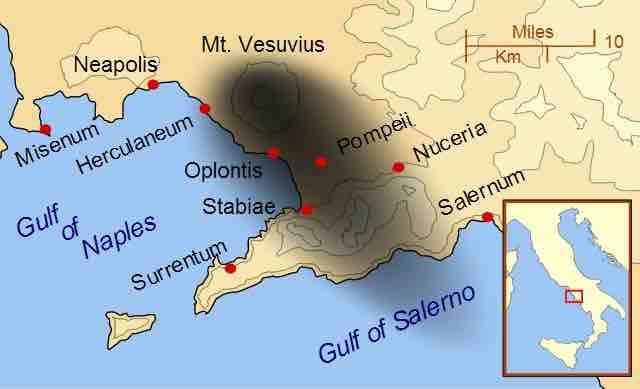The Eruption in August 79 CE
During the Roman Republic and into the early Empire, the area today known as the Bay of Naples was developed as a resort-type area for elite Romans escaping the pressure and politics of Rome. The region was dominated by Mt. Vesuvius, which famously erupted in August 79 CE, burying and preserving the cities of Herculaneum, Pompeii, along with the region's villas and farms. While today the cities of Pompeii and Herculaneum are often described as cities frozen in time, the inhabitants of these cities and the region around Vesuvius had many warnings prior to the eruption that something was about to happen. A major earthquake shook the region in 62 CE, causing damage to buildings that still had not been repaired by the time of volcano's eruption seventeen years later. In the days leading up to the eruption the number of tremors became more frequent. While not everyone left prior to the eruption, archaeological evidence shows that people did leave the city. Some houses give the impression of having been packed up and in some cases furniture and objects were excavated jumbled together. Other objects of value appear to have been buried or hidden. There is evidence of people returning after the eruption to dig through the remains—either recovering lost goods or looting for valuables.
When Vesuvius erupted on August 25, a cloud of ash spewed south, burying the cities of Pompeii, Nuceria, and the sumptuous villas at Stabiae. The ash suffocated the remaining population; empty cavities within the ash are all that remains of those who died on the site. A pyroclastic flow of superheated gas and rock went west to the coast and the city of Herculaneum. Unlike the ash blanket of Pompei, in which organic material decomposed, the pyroclastic flow in Herculaneum petrified organic material, ensuring the preservation of human remains and wood, including the preservation of wooden screens, beds, and shelving. Many of the frescoes, mosaics, and other non-organic materials in both ash and pyroclastic flow were preserved until their excavation in the modern period.

Ash Cloud of Mt. Vesuvius
Ash cloud of Mt. Veusvius, Bay of Naples, Italy.
Rediscovery
The Roman historian Pliny the Elder documented the eruption and lost his life during it. While the cities lingered in the memories of many Romans of the period, they were eventually forgotten, only to be rediscovered in the 18th century when the region was ruled by the King of Naples, Charles Bourbon. Excavations continued on and off over the next two centuries, and the sites of Pompeii and Herculaneum became major tourists attractions for visiting royalty, members of the Grand Tour, and even tourists today.